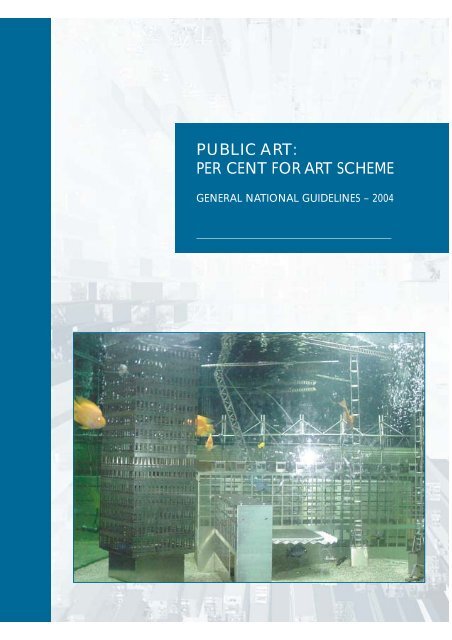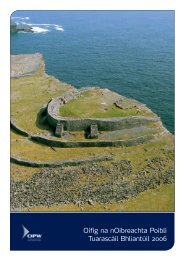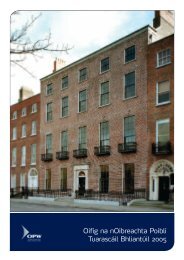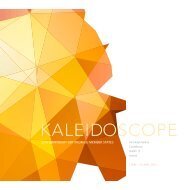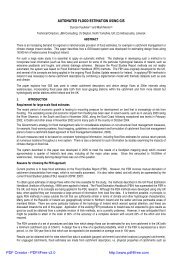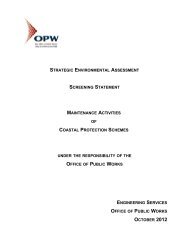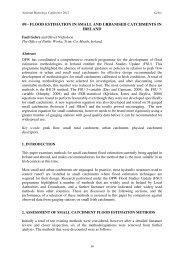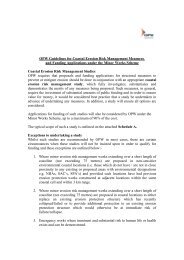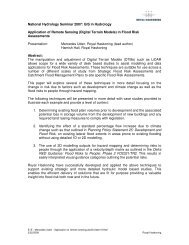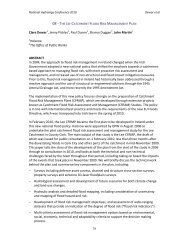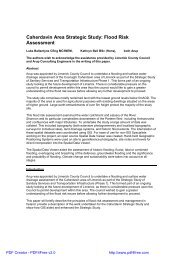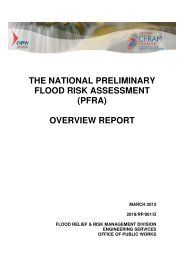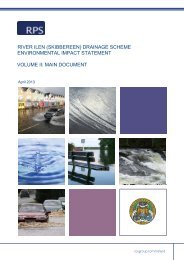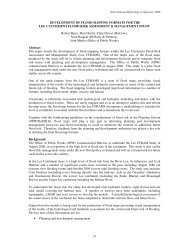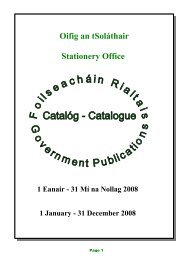per cent for art scheme - The Office of Public Works
per cent for art scheme - The Office of Public Works
per cent for art scheme - The Office of Public Works
You also want an ePaper? Increase the reach of your titles
YUMPU automatically turns print PDFs into web optimized ePapers that Google loves.
PUBLIC ART:<br />
PER CENT FOR ART SCHEME<br />
GENERAL NATIONAL GUIDELINES – 2004
Cover Picture<br />
Subaquatic Dublin, 2004, by Paul Gregg<br />
Commissioned by Our Lady's Hospital <strong>for</strong> Sick Children, Crumlin,<br />
with <strong>The</strong> Ark
Table <strong>of</strong> Contents<br />
1 Preface by Minister 5<br />
2 Foreword 9<br />
3 Introduction 13<br />
3.1. Brief History 15<br />
3.2. Purpose <strong>of</strong> Guidelines 15<br />
3.3. Implementation <strong>of</strong> the Scheme 16<br />
3.4. Scope <strong>of</strong> the Scheme 16<br />
3.5. Overview 16<br />
4 Funding Levels 19<br />
4.1 Stipulations 21<br />
4.2 Budgets 21<br />
4.3 Pooling 21<br />
4.4 Related Costs 22<br />
5 Implementing the Scheme 25<br />
5.1 Best Practice Principles 27<br />
5.2 Commissioning Options 28<br />
5.3 Stages <strong>of</strong> a <strong>Public</strong> Art Project 28<br />
Stage 1 - Planning 29<br />
Stage 2 - Selection 32<br />
Stage 3 - Research and Development 34<br />
Stage 4 - Realisation 35<br />
Stage 5 - Review 37<br />
Appendices 39<br />
Appendix 1 Membership <strong>of</strong> the Guidelines Development Groups 41<br />
Appendix 2 Sample Capital Construction Project Budget 42<br />
Appendix 3 Commissioning Options 44<br />
Appendix 4 Artists Brief 46<br />
Appendix 5 Checklist <strong>of</strong> Areas to be considered when drawing up a Contract 47<br />
Appendix 6 Sample Inventory Sheet 48<br />
Appendix 7 Project Review and Evaluation 49<br />
Selected Bibliography and Reports 50<br />
PER CENT FOR ART SCHEME
PREFACE BY MINISTER<br />
1<br />
Preface
Sisters, 2003, by John Kindness, (Michelle and Yvonne Dunne) Civic Centre, Ballymun<br />
Commissioned by Breaking Ground, the Ballymun Regeneration Ltd.
1<br />
Preface<br />
by Minister<br />
Throughout history, the <strong>art</strong>ist has shown an overwhelming desire to engage with the<br />
physical and geographical context <strong>of</strong> society. This has been successfully achieved when<br />
the <strong>art</strong>work engages with a specific place or event. It can contribute to the<br />
distinctiveness <strong>of</strong> the local area and can <strong>of</strong>fer a different reading or interpretation <strong>of</strong><br />
history or the environment. In Ireland, we look to <strong>art</strong>ists’ work and their<br />
interpretation <strong>of</strong> place to gauge our own development as a community. This<br />
interpretation gains more significance when it is placed in a p<strong>art</strong>icular site or area.<br />
In re<strong>cent</strong> times we have all become more conscious <strong>of</strong> the environment and the effect<br />
it has on our lives.Art has a vital role to play in our environment and has, in fact,<br />
become an integral p<strong>art</strong> <strong>of</strong> many urban areas.A high quality environment is essential<br />
<strong>for</strong> good quality <strong>of</strong> life and high quality public <strong>art</strong> is necessary to create that<br />
environment, be it an open space, public building, hospital or education facility.<br />
<strong>The</strong> Per Cent <strong>for</strong> Art Scheme is a great opportunity <strong>for</strong> collaboration between <strong>art</strong>ist and<br />
community. <strong>Public</strong> <strong>art</strong> needs to have been developed and created with local ownership<br />
in mind.<strong>The</strong> Government has demonstrated its commitment to public <strong>art</strong> through its<br />
approval <strong>of</strong> funding <strong>for</strong> this Scheme and it has already achieved a rich variety <strong>of</strong><br />
<strong>art</strong>works. Many such <strong>art</strong>works, although <strong>per</strong>haps only ex<strong>per</strong>ienced in passing, make an<br />
impact and create lasting memories.<strong>The</strong> potential to exploit this Scheme to its fullest<br />
is available to all Government Dep<strong>art</strong>ments, its agencies and local authorities and this<br />
potential holds enormous opportunities to shape the spaces we inhabit.<br />
<strong>The</strong>se Guidelines are intended to assist and encourage all Government Dep<strong>art</strong>ments<br />
and public bodies to p<strong>art</strong>icipate in the Scheme. I hope that these Guidelines, which<br />
represent a first step in developing a national approach to public <strong>art</strong>, will result in<br />
<strong>art</strong>works that will excite our imagination and increase our engagement with <strong>art</strong>.<br />
I would like to thank all those who were involved in the drafting <strong>of</strong> the Guidelines, the<br />
members <strong>of</strong> the Inter-Dep<strong>art</strong>mental <strong>Public</strong> Art Co-ordination Group, the Panel <strong>of</strong> Art<br />
Ex<strong>per</strong>t Advisors and all those who p<strong>art</strong>icipated in the <strong>Public</strong> Art Consultative<br />
meetings, organised by the Arts Council.<strong>The</strong>ir longer-term goal <strong>of</strong> developing a<br />
national approach to the Per Cent <strong>for</strong> Art Scheme is intended to be achieved over the<br />
next two years. In the interim, the mark <strong>of</strong> their achievement will be heightened<br />
awareness and increased level <strong>of</strong> implementation <strong>of</strong> the Per Cent <strong>for</strong> Art Scheme.<br />
John O’Donoghue TD<br />
Minister <strong>for</strong> Arts, Sports and Tourism<br />
PREFACE BY MINISTER 5
FOREWORD<br />
2<br />
Foreword
<strong>The</strong> Whis<strong>per</strong> <strong>of</strong> Ghosts, 2004, by Composer Elaine Agnew<br />
(Rehersals in progress)<br />
Music Commissioned by Wex<strong>for</strong>d County Council
2 Foreword<br />
<strong>Public</strong> <strong>art</strong>, broadly defined, can take many <strong>for</strong>ms and <strong>per</strong><strong>for</strong>m many functions. It may<br />
be an object <strong>of</strong> civic pride or a cause <strong>of</strong> stimulating debate. It may provide edification<br />
or entertainment. It may be a source <strong>of</strong> private pleasure and solace or popular selfrecognition<br />
and inclusion. While public <strong>art</strong> has traditionally been conceived primarily<br />
in terms <strong>of</strong> the plastic <strong>art</strong>s - most p<strong>art</strong>icularly <strong>per</strong>manent outdoor sculpture – a<br />
broader range <strong>of</strong> possibilities has been fruitfully explored in re<strong>cent</strong> years. <strong>The</strong> scope<br />
<strong>of</strong> public <strong>art</strong> has widened to include not just sculpture’s close relations, architecture<br />
and painting, but also music, literature, film, video, multimedia and sound <strong>art</strong>, as well as<br />
the various <strong>per</strong> <strong>for</strong>ming <strong>art</strong>s including theatre, dance, o<strong>per</strong>a, <strong>per</strong><strong>for</strong>mance and live <strong>art</strong>.<br />
<strong>The</strong> requirement <strong>of</strong> <strong>per</strong>manence has also been called into question. Permanent <strong>art</strong><br />
works can effectively celebrate significant aspects <strong>of</strong> civic life or commemorate crucial<br />
moments <strong>of</strong> communal history. <strong>The</strong>y can also, however, all too soon come to<br />
encapsulate redundant values in outmoded <strong>for</strong>ms. Some <strong>of</strong> the most memorable<br />
public <strong>art</strong>works <strong>of</strong> re<strong>cent</strong> years, both in Ireland and abroad, have been physically<br />
im<strong>per</strong>manent.<strong>The</strong> flexibility and latitude af<strong>for</strong>ded by temporary public <strong>art</strong> should not<br />
be underestimated.At the very least, the memory <strong>of</strong> ambitious and challenging<br />
<strong>art</strong>works <strong>of</strong> this nature may be cherished by those who appreciate them long after the<br />
grumbling has subsided from those who do not. Given that comprehensive<br />
documentation is an important aspect <strong>of</strong> such <strong>art</strong>works, they can also have a valuable<br />
afterlife in the <strong>for</strong>m <strong>of</strong> imaginatively conceived and distributed publications.<br />
<strong>Public</strong> <strong>art</strong>works based on the principle <strong>of</strong> the spectacle can sometimes be<br />
spectacularly successful, but this is not always the case. <strong>The</strong> sheen <strong>of</strong> the spectacular,<br />
like that <strong>of</strong> novelty, soon wears <strong>of</strong>f. Bigger is not necessarily better.<strong>The</strong> Irish habit <strong>of</strong><br />
cutting the most grandiose monuments down to size by a well-turned nickname<br />
suggests that subtler interventions into public space may be more rewarding. Some <strong>of</strong><br />
the most successful public <strong>art</strong>works are projects <strong>of</strong> deceptively modest scale that are<br />
truly integrated into their contexts, rather than merely playing lip-service to a notion<br />
<strong>of</strong> site-specificity that is <strong>of</strong>ten spurious or su<strong>per</strong>ficial.<strong>The</strong> best <strong>art</strong>ists working in the<br />
public arena are intimately aware <strong>of</strong> their chosen physical and social environment, yet<br />
avoid being miscast in the role <strong>of</strong> untrained and unskilled social workers.<br />
<strong>The</strong> best public <strong>art</strong> is in<strong>for</strong>med by a knowledge <strong>of</strong> the needs and expectations <strong>of</strong> all<br />
those involved, from the body initiating the project to the community that project is<br />
designed to address. This does not mean merely giving the public what it wants, <strong>for</strong><br />
this would preclude the possibility <strong>of</strong> truly innovative <strong>art</strong>. <strong>The</strong> public cannot express a<br />
desire <strong>for</strong> that which it has not yet ex<strong>per</strong>ienced. An effective public <strong>art</strong>work does not<br />
patronise or placate its public.<strong>The</strong> instant gratification <strong>of</strong> populism must be balanced<br />
against the demands <strong>of</strong> enduring quality and peer-approved pr<strong>of</strong>essionalism. <strong>The</strong>re is a<br />
need <strong>for</strong> pr<strong>of</strong>essional ex<strong>per</strong>tise at every step in the process. In<strong>for</strong>med decisions can<br />
not be taken by the inex<strong>per</strong>ienced. Ultimately, however, there can be no public <strong>art</strong><br />
FOREWORD 9
without an engaged and responsive public, even if the precise ‘public’ in question may<br />
need to be <strong>for</strong>ged anew by each project. It is there<strong>for</strong>e im<strong>per</strong>ative that structural pro<br />
visions be made that take due account <strong>of</strong> the complexity <strong>of</strong> the relationship between<br />
the planned <strong>art</strong>work and its eventual public at each and every stage <strong>of</strong> the process <strong>of</strong><br />
its development.<br />
Caoimhín Mac Giolla Léith,<br />
Member <strong>of</strong> the Panel <strong>of</strong> <strong>Public</strong> Art Ex<strong>per</strong>t Advisors<br />
10 PER CENT FOR ART SCHEME
INTRODUCTION<br />
3<br />
Introduction
Perpetual Motion, 1995, by Rachael Joynt & Remco de Fouw<br />
Commissioned by Kildare County Council
3 Introduction<br />
3.1 Brief History<br />
In 1978 the OPW established a <strong>scheme</strong> based on the principles <strong>of</strong> Per Cent <strong>for</strong> Art.<br />
In 1986 the Dep<strong>art</strong>ment <strong>of</strong> the Environment established a similar <strong>scheme</strong> titled the<br />
Artistic Embellishment Scheme. A decision in 1994 to review both <strong>scheme</strong>s led to the<br />
publication <strong>of</strong> the <strong>Public</strong> Art Research Project – Steering Group Report to Government<br />
(PART Report). In 1997, on the basis <strong>of</strong> the recommendations <strong>of</strong> the PART Report, the<br />
Government approved the revision and extension <strong>of</strong> the existing Schemes to all<br />
Government Dep<strong>art</strong>ments with construction budgets. Since that time the Scheme has<br />
been implemented in varying degrees by Government Dep<strong>art</strong>ment and public bodies.<br />
To assist in achieving full and effective implementation <strong>of</strong> the Scheme these Guidelines<br />
have been drafted by an Inter-Dep<strong>art</strong>mental <strong>Public</strong> Art Coordination Group, with the<br />
assistance <strong>of</strong> a Panel <strong>of</strong> <strong>Public</strong> Art Ex<strong>per</strong>t Advisors. Details <strong>of</strong> the membership <strong>of</strong> these<br />
groups is set out in Appendix 1 (see page 41).<strong>The</strong> Arts Council, on behalf <strong>of</strong> the<br />
Inter-Dep<strong>art</strong>mental <strong>Public</strong> Art Coordination Group also hosted a series <strong>of</strong> four <strong>Public</strong><br />
Art Consultative Meetings in Cork and Dublin.<strong>The</strong>se meetings invited approximately<br />
<strong>for</strong>ty members <strong>of</strong> the <strong>art</strong>s community, including practicing <strong>art</strong>ists, commissioning<br />
agents, project managers, and curators who are currently involved in Irish public <strong>art</strong><br />
practice, to respond to specific elements <strong>of</strong> the draft guidelines <strong>for</strong> the Per Cent <strong>for</strong> Art<br />
Scheme and the planned two-year review and development <strong>per</strong>iod.<br />
3.2 Purpose <strong>of</strong> the Guidelines<br />
It is the purpose <strong>of</strong> the Guidelines to provide a common national approach to<br />
implementation <strong>of</strong> the Per Cent <strong>for</strong> Art Scheme <strong>for</strong> public bodies delivering capital<br />
construction projects 1 .<strong>The</strong> objective is to achieve clarity and consistency in<br />
procedures, to allow <strong>for</strong> openness and flexibility in planning, selection and review<br />
processes and to further develop commissioning practices.<br />
<strong>The</strong>se Guidelines aim to set out basic o<strong>per</strong>ational procedures <strong>for</strong> staff within<br />
Government Dep<strong>art</strong>ments and related agencies, and Local Authorities implementing<br />
the Per Cent <strong>for</strong> Art Scheme. <strong>The</strong> Guidelines are general in nature because <strong>of</strong> their<br />
universal application. Individual bodies may wish to issue more specific instructions on<br />
the implementation <strong>of</strong> the Scheme within their own area and this is encouraged<br />
provided that there is no conflict with these Guidelines.<br />
1<br />
<strong>The</strong> term capital construction project is used to refer to the full spread <strong>of</strong> work carried out under this heading, including<br />
construction, restoration, refurbishment and urban and rural renewal <strong>scheme</strong>s, etc.<br />
PER CENT FOR ART SCHEME<br />
INTRODUCTION 15
3.3 Implementation <strong>of</strong> the Per Cent <strong>for</strong> Art Scheme<br />
To achieve full and effective implementation <strong>of</strong> the Scheme, it is recognised that a<br />
strategic national approach is required and these Guidelines are a first step in this<br />
approach. <strong>The</strong> Guidelines are the initial steps in setting out best practice principles in<br />
order to achieve successful national implementation <strong>of</strong> the Scheme and have been<br />
developed with an in-built evaluation process which focuses on in-practice review. In<br />
the drafting process, where possible due regard was taken <strong>of</strong> national and international<br />
models <strong>of</strong> good practice.<br />
It is intended to designate a two-year <strong>per</strong>iod as a development phase in working<br />
towards a national approach to public <strong>art</strong> and it is recognised that future revision <strong>of</strong><br />
the Guidelines may be necessary.<br />
3.4 Scope <strong>of</strong> the Scheme<br />
<strong>Public</strong> <strong>art</strong> creates a dialogue with a people, a time and a place.<strong>The</strong> Per Cent <strong>for</strong> Art<br />
Scheme gives the Irish public the opportunity to ex<strong>per</strong>ience a vast range <strong>of</strong><br />
contemporary <strong>art</strong>, borne out <strong>of</strong> capital constructions projects, in their everyday life. In<br />
turn it provides a challenge and an opportunity to a wide range <strong>of</strong> <strong>art</strong>ists to create<br />
work <strong>for</strong> public engagement and response.<br />
<strong>Public</strong> <strong>art</strong> can be <strong>of</strong> any <strong>for</strong>m and can work within or across many <strong>art</strong> <strong>for</strong>ms, such as<br />
visual <strong>art</strong>, dance, film, literature, music, o<strong>per</strong>a, theatre and architecture; including all<br />
aspects <strong>of</strong> contemporary <strong>art</strong>s practice such as <strong>per</strong><strong>for</strong>mance, live <strong>art</strong>, multimedia, video<br />
<strong>art</strong>, sound <strong>art</strong>, etc. <strong>Works</strong> under the <strong>scheme</strong> can be <strong>of</strong> any duration, temporary or<br />
<strong>per</strong>manent, and can be <strong>cent</strong>red in an urban or rural context.<br />
3.5 Overview<br />
This document covers two key sections, Funding <strong>of</strong> the Per Cent <strong>for</strong> Art Scheme and<br />
Implementation <strong>of</strong> the Per Cent <strong>for</strong> Art Scheme.<br />
16 PER CENT FOR ART SCHEME
FUNDING<br />
4<br />
Funding
Dry, 2001, by Locky Morris<br />
Commissioned by Bundoran Town Council
4 Funding<br />
4.1 Stipulations<br />
In relation to individual capital construction budgets it is essential that the:-<br />
●<br />
●<br />
●<br />
Per Cent <strong>for</strong> Art Scheme budget is included in the overall capital construction<br />
project budget estimate. This must be done by the commissioning body<br />
at the inception <strong>of</strong> the project.<br />
Per Cent <strong>for</strong> Art Scheme budget is ring-fenced i.e. it is secured and not available <strong>for</strong><br />
any other element <strong>of</strong> the project.<br />
Amount <strong>of</strong> the Per Cent <strong>for</strong> Art Scheme budget relates to the total capital<br />
construction cost, calculated in accordance with the limits noted below.<br />
4.2 Per Cent <strong>for</strong> Art Scheme Budgets<br />
<strong>The</strong> Government decision <strong>of</strong> August 1997 approves the inclusion in the budgets <strong>for</strong> all<br />
capital construction projects <strong>of</strong> up to 1% as funding <strong>for</strong> an <strong>art</strong> project, subject to limits<br />
as follows:<br />
● Construction projects costing up to €2,550,000 may include an <strong>art</strong> budget <strong>of</strong> 1%<br />
<strong>of</strong> net construction costs i.e.€25,500.<br />
● For projects costing between €2,550,000 and €6,300,000, an <strong>art</strong> budget <strong>of</strong> 1%<br />
up to a maximum <strong>of</strong> €38,000 is allowed.<br />
● For projects costing between €6,300,000 and €12,700,000, an <strong>art</strong> budget <strong>of</strong><br />
€51,000 is allowed.<br />
● For projects costing in excess <strong>of</strong> €12,700,000, an <strong>art</strong> budget <strong>of</strong> €64,000 is<br />
allowed.<br />
<strong>The</strong>se figures should not be regarded as an overall limit <strong>for</strong> <strong>art</strong> projects as in many<br />
cases there may be potential to supplement this with other funding attracted from<br />
other sources, (e.g. private sponsorship and pooling <strong>of</strong> resources, etc).<br />
For Design Build or <strong>Public</strong> Private P<strong>art</strong>nership (PPP) capital construction projects, the<br />
client should ensure that the Per Cent <strong>for</strong> Art Scheme is embedded within the<br />
specification and contract.<br />
See Appendix 2 (see page 42) <strong>for</strong> capital project budget example.<br />
4.3 Pooling<br />
In order to allow greater flexibility in the use <strong>of</strong> funds under the Scheme, the pooling<br />
<strong>of</strong> funds may be adopted. Funding may be pooled within an agency or on an<br />
FUNDING 21
inter agency basis. Some public bodies may wish to gather funding from different<br />
projects in the one area to achieve a more substantial <strong>art</strong> project.<br />
Furthermore, a Government Dep<strong>art</strong>ment and a local authority may pool resources <strong>for</strong><br />
projects within the one area to achieve a joint <strong>art</strong> project.<br />
Models <strong>of</strong> commissioning embracing the principle <strong>of</strong> pooling <strong>of</strong> funds within a local<br />
authority and interagency context include the Placing Art Programme by Sligo County<br />
Council [1998 - 2002], In | Context series by South Dublin County Council [1998 -<br />
2001] and the current Breaking Ground series by Ballymun Regeneration Ltd [2001 -<br />
2011].<br />
4.4 Related Costs<br />
If no other budget is available, a small element <strong>of</strong> the Per Cent <strong>for</strong> Art Scheme budget<br />
earmarked <strong>for</strong> <strong>art</strong> projects in any year may be used <strong>for</strong> related costs such as public<br />
engagement initiatives, publications, documentation or, where appropriate, maintenance<br />
and repair.<br />
However, it must be borne in mind that the primary purpose <strong>of</strong> the <strong>scheme</strong> is to<br />
facilitate the commissioning or acquisition <strong>of</strong> new <strong>art</strong> and funding made available under<br />
the <strong>scheme</strong> should be used <strong>for</strong> this purpose to the greatest extent possible.<br />
22 PER CENT FOR ART SCHEME
IMPLEMENTING THE<br />
SCHEME<br />
YOU’D HAVE AT LEAST<br />
ONE NICKNAME ...<br />
We’re called <strong>The</strong> Piggies<br />
<strong>The</strong> Lonesome Boatman<br />
<strong>The</strong> Elder Lemons<br />
<strong>The</strong> Golden Hands<br />
<strong>The</strong> Reverend<br />
<strong>The</strong> Rixer<br />
<strong>The</strong> Celt<br />
<strong>The</strong> Pig<br />
<strong>The</strong> Duck<br />
<strong>The</strong> Gannet<br />
<strong>The</strong> Bull<br />
<strong>The</strong> Penguin<br />
IT’S LIKE A ZOO IN HERE<br />
You’ve a Short Fuse<br />
Rosie & Jim<br />
Half Acre<br />
College<br />
Ringy<br />
T/z<br />
Punty<br />
Norman Bates<br />
Doom and Gloom<br />
Jake and the Fat Man<br />
Bar & Lounge<br />
Bar & Snug<br />
Mini-bar<br />
& Mrs Jones<br />
5<br />
Implementing<br />
the <strong>scheme</strong><br />
AND THEN THERE ARE THE ONES I CAN’T MENTION
When the bells go down, 2001, a portrait <strong>of</strong> Cork City Fire Brigade, by Judy Kravis & Peter Morgan<br />
Commissioned by Cork County Council
5<br />
Implementation<br />
<strong>of</strong> Scheme<br />
5.1 Best Practice Principles<br />
<strong>The</strong> practice <strong>of</strong> public <strong>art</strong> has developed significantly in Ireland p<strong>art</strong>icularly in the last<br />
ten years. <strong>Public</strong> <strong>art</strong> practice now encompasses a wide variety <strong>of</strong> contextual <strong>art</strong>s<br />
practice, across <strong>art</strong> <strong>for</strong>ms, temporary as well as <strong>per</strong>manent and has become process<br />
orientated rather than purely product or outcome focused.<strong>The</strong>re<strong>for</strong>e a wide variety<br />
<strong>of</strong> possibilities are presented when commissioning public <strong>art</strong>.<br />
<strong>The</strong> procurement process <strong>for</strong> the expenditure <strong>of</strong> the Per Cent <strong>for</strong> Art Scheme budget<br />
must be fair, open, transparent and accountable, in line with the normal principles <strong>of</strong><br />
the ‘<strong>Public</strong> Procurement Process’.<br />
Each commissioning body should set a clear vision on how and why they wish to work<br />
with <strong>art</strong>ists and correspondingly clear criteria <strong>for</strong> selecting and evaluating <strong>art</strong> projects<br />
commissioned under the Per Cent <strong>for</strong> Art Scheme. Each public <strong>art</strong> project is unique and<br />
has an individual story to tell, so the criteria relating to it should be specific.<br />
Good commissioning practice prioritises:<br />
5.1.1 Time – Commissioning public <strong>art</strong> essentially requires time.Taking a good<br />
idea and turning it into a reality requires a large amount <strong>of</strong> planning, initiative<br />
and the ability to deal with the un<strong>for</strong>eseen. In planning the project, time must<br />
be allowed <strong>for</strong> productive dialogue <strong>for</strong> <strong>art</strong>ists to respond to the brief, <strong>for</strong><br />
research and development and <strong>for</strong> commissioner feedback.<br />
5.1.2 Early Integration – <strong>The</strong> <strong>art</strong>ist should be engaged or commissioned at the<br />
same time that the capital construction project is being conceived. This will<br />
ensure early dialogue between the commissioner and the <strong>art</strong>ist, including<br />
input into design decisions that may later affect the context <strong>for</strong> the <strong>art</strong>s<br />
project on realisation.<br />
5.1.3 Artistic Advice – <strong>The</strong> utilisation <strong>of</strong> pr<strong>of</strong>essional <strong>art</strong>istic advice at the earliest<br />
possible stage in planning projects will maximise the opportunity <strong>for</strong> a<br />
meaningful input by <strong>art</strong>ists.This advice is essential in the development <strong>of</strong> a<br />
clear and creative vision <strong>for</strong> the commissioning process.<br />
5.1.4 Artists’ Brief – A clear, researched and unambiguous brief creates a clear<br />
framework <strong>for</strong> <strong>art</strong>ists to respond to.<strong>The</strong> quality <strong>of</strong> the brief affects the quality<br />
<strong>of</strong> the <strong>art</strong>ists’ submissions.<br />
5.1.5 Responsibility <strong>of</strong> the Commissioning Body and Support Staff –<br />
Commissioned <strong>art</strong>ists may be undertaking work <strong>of</strong> a nature that has never<br />
been seen previously in the context <strong>of</strong> a capital construction project;<br />
there<strong>for</strong>e support from the commissioning body is seen as an essential input.<br />
Similar to specialised procurement in the fields <strong>of</strong> engineering and<br />
architecture, public <strong>art</strong> commissioning requires the specialist skills <strong>of</strong> a<br />
IMPLEMENTATION OF SCHEME 27
pr<strong>of</strong>essional <strong>art</strong>s project manager (such as the <strong>Public</strong> Arts <strong>Office</strong>r) to<br />
coordinate all aspects <strong>of</strong> the commission, and assist with projects and<br />
problems as they arise. <strong>Public</strong> <strong>art</strong> specialist staff will deal with policy<br />
development, public engagement and project management. Where possible<br />
this expense should be absorbed into the overall project budget as a category<br />
<strong>of</strong> consultancy fees, along with other pr<strong>of</strong>essional consultancy fees such as<br />
that <strong>of</strong> the Quantity Surveyor, Architect, Engineer, etc. Where this is not<br />
possible it must be borne in mind, as stated above in para 4.4 that the funding<br />
under the <strong>per</strong> <strong>cent</strong> <strong>for</strong> <strong>art</strong> <strong>scheme</strong> should be used to the greatest extent<br />
possible <strong>for</strong> the commissioning or acquisition <strong>of</strong> <strong>art</strong>.<br />
5.2 Commissioning<br />
Commissioning bodies, can develop projects through a variety <strong>of</strong> public <strong>art</strong><br />
procurement processes.<strong>The</strong>se include:<br />
1 Open Competition<br />
2 Limited Competition<br />
3 Direct Invitation or Purchase<br />
Commissioners may wish to utilise a number <strong>of</strong> public <strong>art</strong> procurement processes on<br />
a p<strong>art</strong>icular project. Careful planning and ex<strong>per</strong>t advice is essential <strong>for</strong> the success <strong>of</strong><br />
such an approach.<br />
See Appendix 3 (page 44) <strong>for</strong> details on how to implement each <strong>of</strong> the<br />
commissioning options.<br />
5.3 Stages <strong>of</strong> a <strong>Public</strong> Art Project<br />
<strong>Public</strong> <strong>art</strong> projects and commissions can be broadly divided into five key stages:<br />
1 Planning<br />
2 Selection<br />
3 Research and Development<br />
4 Realisation<br />
5 Review<br />
A clear record <strong>of</strong> each stage should be maintained <strong>for</strong> overall review purposes.<br />
28 PER CENT FOR ART SCHEME
STAGE 1 – PLANNING<br />
Context<br />
In commissioning public <strong>art</strong> context is paramount. Context can be described as the<br />
environment in which a commission is planned and realised. Commissioners are<br />
encouraged to adopt a researched and flexible approach to the context <strong>for</strong> a<br />
commission.This will allow the <strong>art</strong> project to make connections with the capital<br />
construction project and the environment connected with that project.<br />
<strong>Public</strong> Art Working Group<br />
A <strong>Public</strong> Art Working Group should be established at an early stage in the capital<br />
project design process. Early consideration is important to ensure the necessary<br />
connections are made between the design process and the context <strong>for</strong> the <strong>art</strong>s<br />
project.<br />
Artistic ex<strong>per</strong>tise is essential at this stage and should represent a minimum <strong>of</strong> two<br />
members <strong>of</strong> the group.<br />
<strong>The</strong> overall membership <strong>of</strong> the <strong>Public</strong> Art Working Group should be drawn as<br />
comprehensively as possible to ensure a broad base <strong>of</strong> support <strong>for</strong> the process and it<br />
helps to have direct support from senior <strong>per</strong>sonnel within the commissioning body.<br />
<strong>The</strong> size and composition <strong>of</strong> this group will depend on the level <strong>of</strong> ex<strong>per</strong>tise required<br />
and on the complexity <strong>of</strong> the project and will require careful consideration in order to<br />
achieve the best outcome. It is good practice to include:<br />
●<br />
●<br />
●<br />
●<br />
●<br />
●<br />
Pr<strong>of</strong>essional practising <strong>art</strong>ist(s), minimum one, preferably two<br />
Independent Art Curator(s) or Artistic Advisor(s) such as <strong>Public</strong> Arts <strong>Office</strong>r or<br />
Local Authority Arts <strong>Office</strong>r, minimum one, preferably two<br />
Construction Project Manager<br />
Representative(s) <strong>of</strong> the Design Team such as Architect or Engineer<br />
Representative(s) <strong>of</strong> the Building Users, Client or Stakeholders<br />
Other relevant ex<strong>per</strong>tise or local social or community representatives<br />
<strong>The</strong> role <strong>of</strong> a <strong>Public</strong> Art Working Group should include:<br />
●<br />
●<br />
●<br />
●<br />
Research into the full scope <strong>of</strong> the capital project and the development <strong>of</strong> a<br />
vision <strong>for</strong> the related public <strong>art</strong> project(s)<br />
Setting out clear aims and objectives <strong>for</strong> the commissioning project or<br />
programme<br />
Development <strong>of</strong> the <strong>art</strong>ists brief, setting out the process <strong>for</strong> procurement and<br />
criteria <strong>for</strong> selection<br />
Decisions on the membership <strong>of</strong> the project selection panel. Commissioners may<br />
wish to include members <strong>of</strong> the <strong>Public</strong> Art Working Group in the project<br />
STAGE 1 – PLANNING 29
●<br />
●<br />
selection panel, thereby making links between the planning and selection stages.<br />
Planning and overseeing further stages <strong>of</strong> the project or programme<br />
Carrying out a review and feeding into the development <strong>of</strong> public <strong>art</strong> policy <strong>for</strong><br />
the commissioning body.<br />
Artists Brief<br />
It is important to develop a clear, creative and well in<strong>for</strong>med brief. As well as creating<br />
a context <strong>for</strong> the <strong>art</strong>ist to apply, it also attracts more interest and produces better<br />
results. When planning a project, time should be allowed <strong>for</strong> <strong>art</strong>ists to respond to the<br />
brief, <strong>for</strong> research and development, <strong>for</strong> client feedback and <strong>for</strong> productive dialogue.<br />
Also, sufficient time must be allowed be<strong>for</strong>e the contract is signed with the <strong>art</strong>ist so as<br />
to facilitate research and development, including further liaison between <strong>art</strong>ists,<br />
commissioner and key stakeholders.<br />
See Appendix 4 (page 46) <strong>for</strong> a sample list <strong>of</strong> in<strong>for</strong>mation to be included in briefing<br />
documents.<br />
Promotion and <strong>Public</strong>ity<br />
Raising awareness <strong>of</strong> the project through publications and other publicity helps to<br />
ensure that the work becomes publicly known and this is an integral element <strong>of</strong><br />
projects existing as public <strong>art</strong>. An <strong>art</strong> project may be controversial and lead to public<br />
debate but the overall effect on the local community should be the ultimate gain.<br />
Encouraging public awareness and engagement with the project will contribute to the<br />
overall outcome <strong>of</strong> the project. Promotion plans, costs and responsibilities should be<br />
agreed at the outset <strong>of</strong> the project between the commissioning body and the <strong>art</strong>ist.<br />
Insurance<br />
<strong>The</strong> commissioning body should satisfy itself that adequate insurance cover is in place.<br />
Project Budget<br />
Commissioners must take into account and allow <strong>for</strong> all costs when commissioning<br />
new work, such as:<br />
●<br />
●<br />
●<br />
●<br />
●<br />
Artist(s) budget and fee (including materials etc.)<br />
Fees and any agreed expenses <strong>for</strong> shortlisted <strong>art</strong>ists<br />
Fees and expenses <strong>for</strong> <strong>art</strong>istic and / or technical representatives on <strong>Public</strong> Art<br />
Working Group and selection panel<br />
Costs <strong>of</strong> research and development (incurred by <strong>art</strong>ist and commissioning body)<br />
Any attendances <strong>of</strong> relevant <strong>per</strong>sonnel (builder, engineer, <strong>art</strong>ist, etc.) <strong>for</strong><br />
installation or <strong>per</strong><strong>for</strong>mance <strong>of</strong> an <strong>art</strong> project that might be due if not defined and<br />
30 PER CENT FOR ART SCHEME
incorporated in the contract <strong>for</strong> construction<br />
● Transport<br />
● Insurance<br />
● Documentation, public engagement initiative including in<strong>for</strong>mation, education and<br />
labelling<br />
● Advertising, promotion and publicity<br />
● Project management costs including review and evaluation<br />
● Contingency (optional: <strong>of</strong> approximately 5%)<br />
A clear record <strong>of</strong> the planning process must be kept <strong>for</strong> overall review purposes.<br />
STAGE 1 – PLANNING 31
STAGE 2 – SELECTION<br />
Selection Panel<br />
A Selection Panel must be set up to review the aims and objectives <strong>for</strong> the<br />
commission set out at planning stage and to select an <strong>art</strong>ist and proposal <strong>for</strong> the<br />
commission in line with that brief. Alternatively the option is available to<br />
commissioners to assign a single curator with specialist <strong>art</strong>istic ex<strong>per</strong>tise to shortlist<br />
and arrange <strong>for</strong> the appointment <strong>of</strong> an <strong>art</strong>ist to work on a commission.<br />
<strong>The</strong> panel members may be drawn from the <strong>Public</strong> Art Working Group. It is good<br />
practice that the panel includes at least one pr<strong>of</strong>essional practising <strong>art</strong>ist working in an<br />
<strong>art</strong> <strong>for</strong>m appropriate to the commission, and at least one pr<strong>of</strong>essional <strong>art</strong>s curator or<br />
advisor. Where the Panel has four or more members, the number <strong>of</strong> p<strong>art</strong>icipants with<br />
<strong>art</strong>istic ex<strong>per</strong>tise should be increased. <strong>The</strong> commissioning body must ensure that all<br />
necessary <strong>art</strong>istic and technical advice is available to the panel.<br />
<strong>The</strong> panel should be in<strong>for</strong>med or agree a process <strong>for</strong> reviewing submissions and<br />
should be provided with the time, systems and skills necessary to manage the<br />
selection process.<strong>The</strong> process <strong>of</strong> reviewing, considering and selecting submissions will<br />
be more effective if led by an agreed chair<strong>per</strong>son or facilitator.<strong>The</strong> option <strong>of</strong> <strong>art</strong>ists<br />
presenting their proposals to the Selection Panel is available to commissioners and if<br />
utilised the time and cost <strong>of</strong> this should be accounted <strong>for</strong>.<br />
<strong>The</strong> Selection Panel will be required to:<br />
●<br />
●<br />
●<br />
●<br />
●<br />
●<br />
●<br />
Remain open<br />
Undergo briefing on the scope <strong>of</strong> the capital project funding the Per Cent <strong>for</strong> Art<br />
Scheme. Those who are new to public <strong>art</strong> commissioning should also be briefed<br />
on the role, nature and potential <strong>of</strong> <strong>art</strong>ists and what they can bring to a project.<br />
Review the commission aims and objectives, set out at Planning stage<br />
Review criteria <strong>for</strong> submissions, outlined in the <strong>art</strong>ists brief<br />
Attend <strong>art</strong>ists’ presentations, where necessary<br />
Assess submissions and select project(s) <strong>for</strong> development and realisation<br />
Provide evaluation feedback on the selection process to the commissioning body<br />
Following the selection process the decision <strong>of</strong> the Selection Panel must be<br />
communicated to relevant staff within the commissioning body.<br />
Formal Approval<br />
<strong>The</strong> commissioning body should decide at the outset <strong>of</strong> the project whether:<br />
1. It will delegate selection authority to the Selection Panel<br />
2. It will make the final decision<br />
32 PER CENT FOR ART SCHEME
In the event that the commissioning body retains ultimate approval, it should set out,<br />
in advance, a number <strong>of</strong> stages at which it should be consulted. <strong>The</strong> stages can be<br />
broadly identified as follows:<br />
1. Approval <strong>of</strong> the Artists’ Brief<br />
2. Approval <strong>of</strong> the Artist selected by the Selection Panel<br />
3. Approval <strong>of</strong> details <strong>of</strong> the commission including timescales, any research and<br />
development to be carried out and a payment schedule<br />
<strong>The</strong> <strong>Public</strong> Art Working Group should ensure that all necessary approvals are obtained<br />
from the commissioning body.<br />
Unsuccessful Artists / Other Options<br />
When communicating decisions to <strong>art</strong>ists the selection panel may <strong>of</strong>fer p<strong>art</strong>icular<br />
comments and feedback, which they wish to be conveyed to the unsuccessful <strong>art</strong>ists in<br />
the letters <strong>of</strong> regret.<br />
Where the selection panel considers that no submission has met with the criteria set<br />
out in the briefing document they may decide to consider other commissioning<br />
options or, where possible, make arrangements to have funding reassigned to future<br />
projects under the Scheme.<br />
A clear record <strong>of</strong> the selection process, including feedback from the selection panel, must be<br />
kept <strong>for</strong> overall review purposes and to in<strong>for</strong>m future projects.<br />
STAGE 2 – SELECTION 33
STAGE 3 – RESEARCH AND DEVELOPMENT<br />
Once an <strong>art</strong>ist is selected, it is advisable to engage in a process <strong>of</strong> research and<br />
development to ensure the success <strong>of</strong> the project. Research is essential <strong>for</strong> <strong>art</strong>ists and<br />
should be built into both the timeframe and budgets at the proposal and contract<br />
stage.<br />
<strong>The</strong> aim <strong>of</strong> the development phase is to ensure that the project reaches a stage where<br />
definite achievable goals, designs or proposals are identified and realistically costed<br />
within the budget.<br />
Once an <strong>art</strong>ist is selected, it may be necessary to spend a portion <strong>of</strong> the budget on<br />
the development and planning phases <strong>for</strong> creative, technical and economic reasons. An<br />
element <strong>of</strong> the budget, appropriate to scale, could be set-aside <strong>for</strong> this and this<br />
process should be governed by a contract between the <strong>art</strong>ist and the commissioner.<br />
Costs and activities at this stage must be agreed in advance and might include<br />
discussions, workshops or a pilot project led by the <strong>art</strong>ist, production <strong>of</strong> sound<br />
recordings, visual material, etc. p<strong>art</strong>icular to the <strong>art</strong><strong>for</strong>m <strong>of</strong> the commission; a site visit<br />
by an architect or engineer to assess the technical feasibility <strong>of</strong> the proposed project<br />
or site or the production <strong>of</strong> engineers’ drawings. Agreed fees paid to <strong>art</strong>ists at the<br />
research and development stage should be sufficient to enable the <strong>art</strong>ist to guarantee<br />
the budgets or technical specifications s/he is proposing.<br />
Research and Development should be pro<strong>per</strong>ly structured and the following should be<br />
discussed, documented and agreed when agreeing this phase:<br />
●<br />
●<br />
●<br />
●<br />
●<br />
●<br />
●<br />
●<br />
Research Description<br />
Timeframe<br />
Deadlines<br />
Fees<br />
Progress / meeting schedule<br />
Documentation<br />
Outcome<br />
Procedure <strong>for</strong> sign-<strong>of</strong>f be<strong>for</strong>e moving to the realisation phase<br />
A clear record <strong>of</strong> the research and development stage must be kept <strong>for</strong> overall review<br />
purposes and to in<strong>for</strong>m future projects.<br />
34 PER CENT FOR ART SCHEME
STAGE 4 – REALISATION<br />
Contractual Arrangements<br />
When the selected submission has been approved a letter <strong>of</strong> contract confirming all<br />
relevant details <strong>of</strong> the commission, including timescale and schedule <strong>for</strong> payment <strong>of</strong><br />
fees, should be issued by or on behalf <strong>of</strong> the commissioning body.<br />
See Appendix 5 (page 47) <strong>for</strong> a checklist <strong>of</strong> areas to be considered by the<br />
Commissioning Body or <strong>Public</strong> Art Working Group when drawing up a contract.<br />
It is vital that discussions continue between the <strong>art</strong>ist, the <strong>Public</strong> Art Working Group<br />
and the commissioning body to ensure that the process remains open and allows <strong>for</strong><br />
creative developments and changes that may occur throughout this stage.<br />
If the strategy is <strong>for</strong> an <strong>art</strong> project to be physically integrated into the building or<br />
structure, the commissioning process should, if possible, be timed so that the building<br />
contractor is still on site. In the case <strong>of</strong> capital construction budgets, <strong>for</strong> example, this<br />
will support the <strong>art</strong>ist working on site under the ‘Artists and Craftsmen’ clause <strong>of</strong> the<br />
Government Dep<strong>art</strong>ments and Local Authority (GDLA) contract used by public<br />
bodies.<br />
A designated member <strong>of</strong> the <strong>Public</strong> Art Working Group or the public <strong>art</strong> project<br />
manager should keep in regular contact with the <strong>art</strong>ist while work on the public <strong>art</strong><br />
project is in progress to ensure that:<br />
●<br />
●<br />
●<br />
All <strong>art</strong>istic, technical and safety aspects are considered and modifications made if<br />
necessary<br />
Progress is in accordance with the commission details and timescale set out in<br />
the contract<br />
Payments are verified<br />
Payment<br />
Prior to commencement <strong>of</strong> the project, a payment schedule should be negotiated,<br />
drawn up and agreed between the commissioning body and the <strong>art</strong>ist. This can, in<br />
principle, include design work in the preparation or development <strong>of</strong> project proposals,<br />
research and development <strong>of</strong> the concept, the purchase <strong>of</strong> materials or hiring <strong>of</strong><br />
<strong>per</strong><strong>for</strong>mers specifically <strong>for</strong> the project, or work undertaken in the making or<br />
<strong>per</strong><strong>for</strong>ming <strong>of</strong> an <strong>art</strong>s project in response to the commission. <strong>The</strong> commissioning<br />
body should ensure that there is a clear and shared understanding with the appointed<br />
<strong>art</strong>ist, at an early stage in the process, in relation to payment procedures and<br />
requirements.<br />
STAGE 4 – REALISATION 35
Documentation and <strong>Public</strong> Engagement<br />
It is important to document all stages <strong>of</strong> the commission, from the <strong>art</strong>ists’ proposal to<br />
project development through to realisation and <strong>per</strong><strong>for</strong>mance or installation. This<br />
in<strong>for</strong>mation provides an important memory and record <strong>of</strong> the process <strong>of</strong> commissioning<br />
and will help commissioners to plan, implement, monitor and evaluate projects. At least<br />
one <strong>per</strong>son should be responsible <strong>for</strong> maintaining a complete record <strong>of</strong> the project as it<br />
develops. Examples <strong>of</strong> documentation include written records, photography, video, DVD,<br />
CD ROM, web based in<strong>for</strong>mation, multimedia, etc.<br />
Labelling <strong>of</strong> the commission, with an explanation <strong>of</strong> the project where necessary, must<br />
be provided, preferably on site and at the time <strong>of</strong> <strong>per</strong><strong>for</strong>mance or installation. This<br />
should be agreed with the <strong>art</strong>ist. Temporary public <strong>art</strong> can also have a valuable after life<br />
in the <strong>for</strong>m <strong>of</strong> imaginatively conceived and distributed publications.<br />
When the <strong>art</strong> project is complete it should be recorded / photographed by a<br />
pr<strong>of</strong>essional photographer or the commissioned <strong>art</strong>ist, <strong>for</strong> inclusion on an inventory to<br />
be maintained by the commissioning body as outlined below.<br />
Conservation and Care<br />
In the case <strong>of</strong> <strong>per</strong>manent <strong>art</strong>s projects the ongoing maintenance <strong>of</strong> <strong>art</strong> is important <strong>for</strong><br />
its long-term preservation and <strong>for</strong> continuing public engagement. <strong>The</strong> commissioning<br />
body must maintain all <strong>art</strong> projects commissioned or purchased under the Per Cent <strong>for</strong><br />
Art Scheme. Regular inspections <strong>of</strong> <strong>art</strong> projects must be carried out to ensure that<br />
they have not been removed or damaged. Occasionally <strong>art</strong> projects may need to be<br />
relocated or repaired. This work should only be undertaken by ex<strong>per</strong>ts, under direction<br />
and in consultation with the commissioned <strong>art</strong>ist. Accordingly, consideration must be<br />
given to making provision in annual revenue budgets <strong>for</strong> all such maintenance projects.<br />
Inventory<br />
As outlined above, the provision <strong>of</strong> public in<strong>for</strong>mation on <strong>art</strong> projects should be an<br />
integral p<strong>art</strong> <strong>of</strong> the Per Cent <strong>for</strong> Art Scheme. <strong>The</strong> commissioning body, should maintain a<br />
database <strong>of</strong> all <strong>art</strong> projects commissioned under the <strong>scheme</strong> and this should be publicly<br />
accessible, <strong>for</strong> example through local libraries or through the organisations website. <strong>The</strong><br />
inventory should include the commission details and a photograph (provided by a<br />
pr<strong>of</strong>essional photographer or the <strong>art</strong>ist). Details <strong>of</strong> any inspections carried out over<br />
time to check the condition <strong>of</strong> the <strong>art</strong> project should be kept on record by the<br />
commissioners and may also be included. Records <strong>of</strong> any publicity or promotion should<br />
also be included.<br />
See Appendix 6 (page 48) <strong>for</strong> a sample inventory sheet and details.<br />
Copyright<br />
Copyright is in accordance with the Copyright and Related Rights Act 2000 (No. 28 <strong>of</strong> 2000).<br />
A clear record <strong>of</strong> the realisation stage must be kept <strong>for</strong> overall review purposes.<br />
36 PER CENT FOR ART SCHEME
STAGE 5 – REVIEW<br />
In order to be effective, methods <strong>of</strong> review and evaluation should be agreed and<br />
established at the beginning <strong>of</strong> a project.<br />
Documentation including written reports compiled at each stage <strong>of</strong> the commissioning<br />
process will serve as the basis <strong>for</strong> overall review. Post completion it is necessary <strong>for</strong><br />
the <strong>Public</strong> Art Working Group to review the public <strong>art</strong> project or programme to<br />
discover what works well and what improvements could be made in the future. A<br />
review <strong>of</strong> the strengths and weaknesses <strong>of</strong> the decisions made and the results <strong>of</strong> each<br />
stage <strong>of</strong> development should be included. <strong>The</strong> commissioning body can utilise the<br />
in<strong>for</strong>mation gathered on future projects or public <strong>art</strong> programmes, including public <strong>art</strong><br />
policy development, public engagement initiatives along with public <strong>art</strong> project<br />
management.<br />
In<strong>for</strong>mation gathered in this way may be <strong>of</strong> p<strong>art</strong>icular value to commissioning bodies<br />
<strong>for</strong> whom the commissioning process is a new ex<strong>per</strong>ience.<br />
See Appendix 7 (page 49) <strong>for</strong> a sample checklist <strong>for</strong> review and evaluation.<br />
STAGE 5 - REVIEW 37
APPENDICES<br />
6<br />
Appemdices
Untitled, 2003, Sculptor at Dundalk Town Hall, by Ronan Halpin<br />
Commissioned by Dundalk Town Council
APPENDIX 1<br />
Inter-Dep<strong>art</strong>mental <strong>Public</strong> Art Coordination Group - Membership<br />
Christine Sisk Dep<strong>art</strong>ment <strong>of</strong> Arts Sports and Tourism Chair<br />
Jackie Hannon Dep<strong>art</strong>ment <strong>of</strong> Arts Sports and Tourism Secretary<br />
Mary Cloake<br />
Arts Council <strong>of</strong> Ireland<br />
Annette Moloney Arts Council <strong>of</strong> Ireland<br />
Michael McKenna/<br />
Betty Mori<strong>art</strong>y<br />
Niall Bradley<br />
Paul de Freine<br />
Helen O’Neill<br />
Angela Rolfe<br />
Jacquie Moore<br />
Dick McKeever<br />
Richard Evers<br />
Comdt David McGonnell<br />
Shay Kirk<br />
Dep<strong>art</strong>ment <strong>of</strong> the Environment, Heritage and<br />
Local Government<br />
City & County Managers Association / Kildare<br />
County Council<br />
Dep<strong>art</strong>ment <strong>of</strong> Health and Children<br />
Dep<strong>art</strong>ment <strong>of</strong> Education and Science<br />
<strong>Office</strong> <strong>of</strong> <strong>Public</strong> <strong>Works</strong><br />
<strong>Office</strong> <strong>of</strong> <strong>Public</strong> <strong>Works</strong><br />
Dep<strong>art</strong>ment <strong>of</strong> Communications, Marine and Natural<br />
Resources<br />
National Roads Authority<br />
Dep<strong>art</strong>ment <strong>of</strong> Defence / Corp <strong>of</strong> Engineers<br />
Court Services Board<br />
Panel <strong>of</strong> <strong>Public</strong> Art Ex<strong>per</strong>t Advisors – Membership<br />
Mary McC<strong>art</strong>hy<br />
Mary McDonagh<br />
Tom de Paor<br />
Declan McGonagle<br />
Caoimhín Mac Giolla Leith<br />
John Fairleigh<br />
Catherine Nunes<br />
Jane O’Leary<br />
Mick Hannigan<br />
Maureen Kennelly<br />
Deputy Director, European City <strong>of</strong> Culture – Cork<br />
2005<br />
<strong>Public</strong> Art <strong>Office</strong>r, Sligo County Council<br />
Architect<br />
Artistic Director, City Arts Centre<br />
Art Curator, Critic & Academic<br />
Writer & Editor<br />
Artistic Director, International Dance Festival<br />
Composer & Director <strong>of</strong> Concorde Ensemble<br />
Director <strong>of</strong> Cork Film Festival<br />
Arts Consultant<br />
APPENDIX 1 41
APPENDIX 2<br />
Sample Capital Project Budget<br />
<strong>The</strong> Per Cent <strong>for</strong> Art budget, based on the <strong>for</strong>mula noted on page 5 check # as applied<br />
to the net construction cost, must be included in the overall project budget from the<br />
early project planning stage and be retained throughout the project.<br />
Example 1:<br />
Construction Project Budget Estimate<br />
Buildings costs €<br />
1500m 2 @ €1,200 <strong>per</strong> m 2 1,800,000<br />
External works 250,000<br />
Net construction cost (expected contract sum) 2,050,000 2,050,000<br />
VAT @ 12.5% 256,250<br />
Total construction costs 2,306,250<br />
Inflation @ 3% 61,500<br />
Consultants fees @ 14% <strong>of</strong> net construction cost 322,875<br />
VAT @ 21% 67,803<br />
Contingency @ 5% 102,500<br />
Planning <strong>per</strong>mission and fire certificate fees 6,750<br />
Utilities 15,000<br />
% <strong>for</strong> Art 20,500 20,500<br />
Total Project Budget €2,903,178<br />
Example 2:<br />
Construction Project Budget Estimate<br />
Building Costs €<br />
4000m 2 @ €750 <strong>per</strong> m 2 3,400,000<br />
External works 500,000<br />
Specialist fixtures 500,000<br />
Net construction cost (expected contract sum) 4,400,000 4,400,000<br />
VAT @ 12.5% 550,000<br />
Total construction costs 4,950,000<br />
Consultants fees @ 15% <strong>of</strong> net construction cost 660,000<br />
VAT @ 21% 138,600<br />
Planning <strong>per</strong>mission and fire certificate fees 18,000<br />
Utilities 25,000<br />
* % <strong>for</strong> <strong>art</strong> 38,000 38,000<br />
Furniture and fittings 50,000<br />
Total project budget €5,879,692<br />
42 PER CENT FOR ART SCHEME
Example 3:<br />
Construction Project Budget Estimate<br />
Building costs €<br />
25,000m 2 @ €1,000 <strong>per</strong> m 2 25,000,000<br />
External works 2,500,000<br />
Specialist fixtures 1,750,000<br />
Net construction cost (expected contract sum) 29,250,000 29,250,000<br />
VAT @ 12.5% 3,656,250<br />
Total construction costs 32,906,250<br />
Contingency @ 3% 987,187<br />
Inflation @ 3% <strong>per</strong> annum <strong>for</strong> 3 years 2,632,500<br />
Consultants fees @ 10% <strong>of</strong> net construction cost 2,925,000<br />
VAT @ 21% 614,250<br />
Planning <strong>per</strong>mission and fire certificate fees 112,500<br />
Utilities 100,000<br />
% <strong>for</strong> Art 64,000 64,000<br />
Total Project Budget €40,341,701<br />
APPENDIX 2 43
APPENDIX 3<br />
Commissioning<br />
Commissioning bodies, such as Government Dep<strong>art</strong>ments, related bodies, and local<br />
authorities can develop projects through a variety <strong>of</strong> public <strong>art</strong> procurement<br />
processes.<strong>The</strong>se include:<br />
1 Open Competition<br />
2 Limited Competition – between invited p<strong>art</strong>ies<br />
3 Direct Invitation or Purchase<br />
Artists may be commissioned through the Per Cent <strong>for</strong> Art Scheme in a variety <strong>of</strong> ways.<br />
1 Open Competition<br />
<strong>The</strong>re are a variety <strong>of</strong> ways by which <strong>art</strong>ists can be recruited through opensubmission<br />
competition through public advertisement:<br />
1.1 A combination <strong>of</strong> slides and CV submitted alongside drawings and / or macquette,<br />
outline project ideas and costings, all sought from the onset.<br />
With this method <strong>of</strong> procurement, it is very important to allow sufficient<br />
time <strong>for</strong> <strong>art</strong>ists to negotiate the place and people with which the project will<br />
engage.This may include research, site visits and liaison time.<br />
1.2 Competition on the basis <strong>of</strong> previous work.<br />
<strong>The</strong> submission <strong>of</strong> slides, catalogues, published material, videos, CD’s etc.<br />
along with the <strong>art</strong>ists’ current CV’s to an ex<strong>per</strong>t selection panel.<br />
1.3 Open Anonymous Competition.<br />
This model aims to ensure that emerging or unknown <strong>art</strong>ists have a chance<br />
to be appointed <strong>for</strong> commissions. A detailed commission brief is drawn up<br />
and distributed and <strong>art</strong>ists respond by submitting actual proposals.<strong>The</strong><br />
Selection Panel does not have access to supporting material on the <strong>art</strong>ist, and<br />
the decision to select is made on the basis <strong>of</strong> the quality <strong>of</strong> the idea<br />
presented and the execution <strong>of</strong> the submission.<br />
In the case <strong>of</strong> each <strong>of</strong> the above methods a shortlist may be drawn up and a fee paid<br />
to the shortlisted <strong>art</strong>ists to undertake further research and development and develop<br />
proposals be<strong>for</strong>e a final selection is made.<br />
44 PER CENT FOR ART SCHEME
2 Limited Competition<br />
For commissions or opportunities <strong>of</strong> a very exacting nature, the route <strong>of</strong> drawing up a<br />
shortlist <strong>of</strong> suitable <strong>art</strong>ists is carefully researched and drawn up by the <strong>Public</strong> Art<br />
Working Group.<strong>The</strong> option is also available to commissioners to assign a single<br />
selector with specialist <strong>art</strong>istic ex<strong>per</strong>tise to shortlist and appoint <strong>art</strong>ists to work on<br />
commissions.<br />
Through a limited competition process <strong>art</strong>ists carry out research and development<br />
and are given adequate time to prepare and submit their proposal. Shortlisted <strong>art</strong>ists<br />
are paid a fee to develop ideas <strong>for</strong> selection and payment is made to each submitting<br />
<strong>art</strong>ist.This is useful whereby the commissioning body, through the research and advice<br />
<strong>of</strong> the <strong>Public</strong> Art Working Group, wants to work with a p<strong>art</strong>icular type <strong>of</strong> <strong>art</strong> or <strong>art</strong>ist.<br />
While this process can work very well, it is worth pointing out that the fee paid to the<br />
<strong>art</strong>ist, at this stage, is not likely to be sufficient to enable the <strong>art</strong>ist to guarantee the<br />
budgets or technical specifications s/he is proposing. Developmental projects may also<br />
require time <strong>for</strong> discussion, collaboration or negotiation with a local community in<br />
order to establish the direction or context <strong>of</strong> the project.<br />
3 Direct Invitation or Purchase<br />
3.1 <strong>The</strong> commissioning body, through the advice <strong>of</strong> the <strong>Public</strong> Art Working<br />
Group, may directly appoint an <strong>art</strong>ist to a commission. Where it is felt after a<br />
<strong>per</strong>iod <strong>of</strong> research and discussion that an <strong>art</strong>ist’s practice or work is<br />
absolutely and exclusively appropriate to the aims and objectives <strong>of</strong> the<br />
commission, the <strong>Public</strong> Art Working Group, working with curators or advisors<br />
where required, can appoint an <strong>art</strong>ist directly to a commission or to work<br />
with a given budget.<br />
3.2 Work can also be directly purchased from an <strong>art</strong>ist or its agent. When using<br />
this option, selection should be made on the basis <strong>of</strong> as comprehensive as<br />
possible a survey <strong>of</strong> what is available.<br />
APPENDIX 3 45
APPENDIX 4<br />
Artists Brief<br />
<strong>The</strong> following is a sample checklist <strong>of</strong> the categories <strong>of</strong> in<strong>for</strong>mation to include in the<br />
<strong>art</strong>ists brief. This list is not definitive or exhaustive.<br />
●<br />
●<br />
●<br />
●<br />
●<br />
●<br />
●<br />
●<br />
●<br />
●<br />
●<br />
●<br />
●<br />
●<br />
●<br />
●<br />
●<br />
●<br />
●<br />
●<br />
●<br />
●<br />
●<br />
●<br />
<strong>The</strong> commissioning body’s vision <strong>for</strong> the project and an indication <strong>of</strong> the range<br />
<strong>of</strong> creative possibilities<br />
<strong>The</strong> background, history and description <strong>of</strong> the capital project being undertaken<br />
and its significance in local/national terms<br />
Detailed description <strong>of</strong> the proposed context <strong>for</strong> the <strong>art</strong> project, if appropriate<br />
venue or location<br />
<strong>The</strong> <strong>art</strong> <strong>for</strong>m desired, if a choice has already been made, if not the scope <strong>of</strong> <strong>art</strong><br />
<strong>for</strong>ms<br />
Details <strong>of</strong> what should be included with an <strong>art</strong>ists submission, such as:<br />
- Outline proposal (drawings/photomontages/videos/audios <strong>of</strong> proposed<br />
<strong>art</strong> project)<br />
- Outline costings, specifications and timescale required to ensure that <strong>art</strong><br />
project can be produced within the commission budget<br />
- Examples <strong>of</strong> previous work; slides, photos, transparencies, laser copies,<br />
jpegs, videos, short stories, fiction, poetry, drama and/or other published<br />
material, DVD's, audio tapes/CD's, web address etc.<br />
- C.V.<br />
An outline <strong>of</strong> the intended selection process<br />
<strong>The</strong> names <strong>of</strong> those on the Selection Panel<br />
<strong>The</strong> total value <strong>of</strong> the commission<br />
<strong>The</strong> items <strong>for</strong> which the <strong>art</strong>ist will be responsible both practically and financially<br />
A timetable setting out the key dates i.e., site visit, if appropriate; deadline <strong>for</strong><br />
receipt <strong>of</strong> submissions; date commission is to be placed and proposed installation<br />
date<br />
<strong>The</strong> extent <strong>of</strong> attendance to be provided by the project contractor e.g. <strong>for</strong> <strong>per</strong><br />
<strong>for</strong>mance or installation, if appropriate<br />
Scaled drawings and/or photographs or descriptions <strong>of</strong> the space/venue, as<br />
appropriate<br />
Note on requirement <strong>for</strong> <strong>art</strong>ist to have due regard to health and safety and<br />
other relevant statutory issues<br />
Any necessary clarifications on arrangements <strong>for</strong> insurance cover<br />
Clarifications on responsibility <strong>for</strong> publications and publicity<br />
Detail <strong>of</strong> submission fee which will be paid and basis <strong>of</strong> payment<br />
Degree <strong>of</strong> community p<strong>art</strong>icipation, if appropriate<br />
Planning <strong>per</strong>mission requirements/environmental issues, if appropriate<br />
Maintenance and lifespan expectation, if appropriate<br />
Copyright position<br />
Notification <strong>of</strong> requirements <strong>for</strong> Tax Clearance Certificate<br />
Details <strong>of</strong> VAT requirements<br />
Liability to disclosure under Freedom <strong>of</strong> In<strong>for</strong>mation<br />
Requirements in relation to compliance with terms <strong>of</strong> the Prompt Payment Act<br />
1997<br />
46 PER CENT FOR ART SCHEME
APPENDIX 5<br />
Checklist <strong>of</strong> areas to be considered when drawing up a contract to an <strong>art</strong>ist<br />
All contracts will differ depending on the individual commission. Not all <strong>of</strong> these areas<br />
will be relevant to every project.<br />
●<br />
●<br />
●<br />
●<br />
●<br />
●<br />
●<br />
●<br />
●<br />
●<br />
●<br />
●<br />
●<br />
●<br />
●<br />
●<br />
●<br />
●<br />
●<br />
●<br />
●<br />
●<br />
●<br />
●<br />
●<br />
●<br />
Artist details<br />
Details <strong>of</strong> p<strong>art</strong>icipation<br />
Commission commencement and proposed completion dates<br />
Project / commission description (attach)<br />
Work plan (attach with payment schedule)<br />
Budget breakdown (research & development, implementation, completion)<br />
Payment schedule<br />
Reporting and collaboration structure (giving the name and contact details <strong>of</strong> the<br />
<strong>per</strong>son with whom the Artist will communicate)<br />
Progress / meeting schedule<br />
Tax Clearance<br />
Copyright<br />
Health & Safety<br />
Insurance<br />
Originality<br />
Licences and <strong>per</strong>mits<br />
Credits<br />
Documentation<br />
Confidentiality<br />
Evaluation<br />
Installation, exhibition or <strong>per</strong><strong>for</strong>mance <strong>of</strong> work<br />
Relocation, reproduction and possible repeat <strong>per</strong><strong>for</strong>mance <strong>of</strong> work<br />
Payments relating to potential sale or production <strong>of</strong> work, such as CDs,<br />
publications etc.<br />
Launch and PR<br />
<strong>Public</strong> In<strong>for</strong>mation and Engagement<br />
Archiving and public records <strong>of</strong> commissions, where appropriate maintenance<br />
and conservation<br />
Signatures<br />
APPENDIX 5 47
APPENDIX 6<br />
Sample inventory sheet<br />
●<br />
●<br />
●<br />
●<br />
●<br />
●<br />
●<br />
●<br />
●<br />
●<br />
●<br />
●<br />
●<br />
●<br />
●<br />
●<br />
Title<br />
Artist<br />
Commissioner<br />
Date commenced<br />
Date completed<br />
Location, Installation or Per<strong>for</strong>mance Venue<br />
Dimensions / Scope<br />
Materials<br />
Total project budget<br />
Funding sources<br />
Summary <strong>of</strong> Artists’ Brief<br />
Project Manager<br />
Other pr<strong>of</strong>essionals<br />
Contractors<br />
Contact <strong>for</strong> further in<strong>for</strong>mation<br />
Documentation <strong>of</strong> the commission, CD, photograph, written record, etc.<br />
48 PER CENT FOR ART SCHEME
APPENDIX 7<br />
Project Review and Evaluation<br />
It is good practice to include the <strong>art</strong>ists, all relevant staff, p<strong>art</strong>icipants and other groups in<br />
the evaluation process.A sample checklist includes:<br />
●<br />
●<br />
●<br />
●<br />
●<br />
●<br />
●<br />
●<br />
●<br />
What worked? Why?<br />
What didn’t work? Why?<br />
Have the aims and objectives <strong>of</strong> the project been met?<br />
Has the vision <strong>of</strong> the commissioners been achieved?<br />
Has the vision <strong>of</strong> the <strong>art</strong>ist been achieved?<br />
What has been the response or feedback?<br />
Has the <strong>art</strong>istic development <strong>of</strong> the <strong>art</strong>ists been enhanced by the ex<strong>per</strong>ience <strong>of</strong><br />
working on this project?<br />
Has the project allowed <strong>for</strong> high quality public engagement?<br />
Drawing on the ex<strong>per</strong>ience <strong>of</strong> working on this project, what recommendations<br />
can be made <strong>for</strong> future projects?<br />
APPENDIX 7 49
SELECTED BIBLIOGRAPHY AND REPORTS<br />
1 <strong>Public</strong> Art Research Project – Steering Group Report to Government<br />
[1996], available on the Dep<strong>art</strong>ment <strong>of</strong> Arts, Sport and Tourism website<br />
(www.gov.ie/<strong>art</strong>s-sport-tourism).<br />
2 Placing Art Programme by Sligo County Council [1998 – 2002] – three<br />
publications:<br />
- A report on the evaluation <strong>of</strong> the pilot public <strong>art</strong> programme Placing Art by the<br />
<strong>Public</strong> Art Steering Group<br />
- A report by the <strong>Public</strong> Art Strategy Group on the future application <strong>of</strong> the<br />
Per Cent <strong>for</strong> Art Scheme by the Sligo Local Authorities<br />
- Placing Art – a Colloquium on <strong>Public</strong> Art in Rural, Coastal and Small Urban<br />
Environments<br />
3 In | Context series by South Dublin County Council [1998 – 2001] –<br />
publication<br />
4 Breaking Ground series by Ballymun Regeneration Ltd [2001 – 2011] –<br />
publications<br />
- Per Cent <strong>for</strong> Art Strategy <strong>for</strong> Ballymun 2001 – 2011, commissioned by Ballymun<br />
Regeneration Ltd.<br />
- Call <strong>for</strong> Entries brochure<br />
5 Carlow County Council’s Visualise Carlow programme – publication<br />
- Visualise Carlow 2001 – 2002<br />
- Visualise Carlow 2002 – 2003<br />
6 Fingal County Council’s Art programme – publication<br />
- Fingal County Council – Art – Commission, Interact, Integrate<br />
Resource material and links will be made available on www.public<strong>art</strong>.ie<br />
50 PER CENT FOR ART SCHEME
Back cover inset colour photo -<br />
Cloud, 2003, by Joy Gerrard<br />
Commissioned by the <strong>Office</strong> <strong>of</strong> <strong>Public</strong> <strong>Works</strong>


